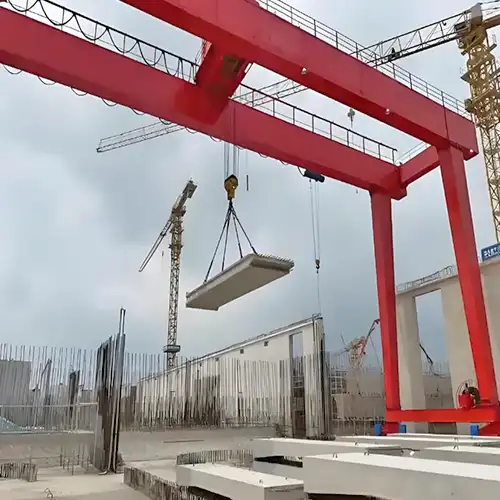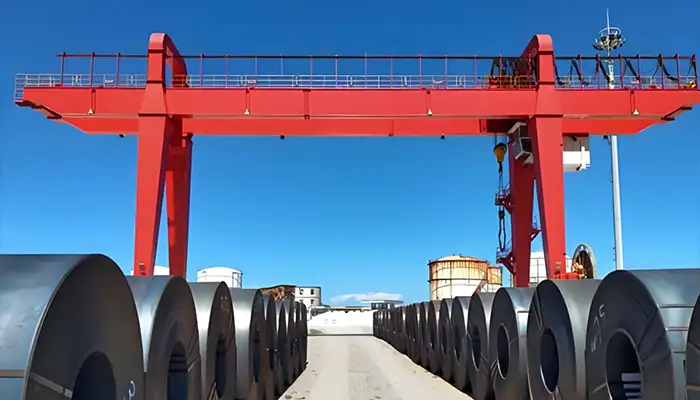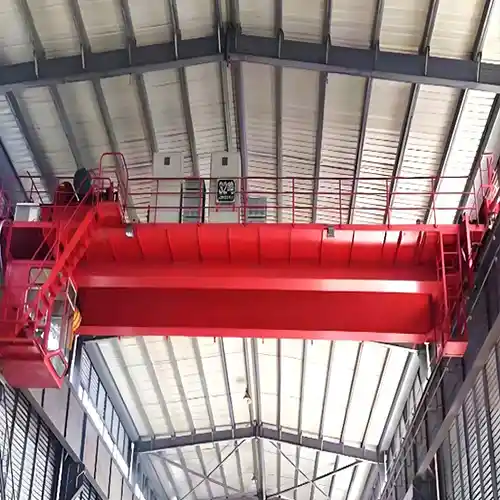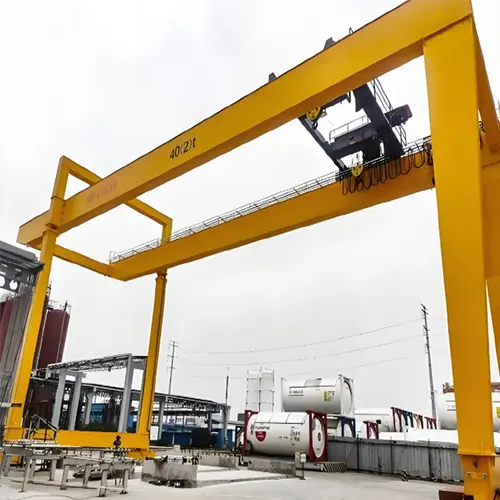Heavy Duty Cranes Classification, Industrial Uses & Buyer Insight
A 5 A6 heavy-duty cranes for sale, their classifications, key factors, industrial applications, and essential buyer insights for informed purchasing decisions.
Category: Featured
Your Trusted Heavy Duty Crane Manufacturer & Supplier
Heavy Duty Cranes for Sale: Classification, Key Factors, and Industrial Uses & Buyer Insight
A 5 A6 heavy-duty cranes for sale, their classifications, key factors, industrial applications, and essential buyer insights for informed purchasing decisions.
Heavy-duty cranes play a crucial role in various industrial operations, providing the necessary strength and reliability to handle heavy loads in demanding environments. These cranes are designed to lift and transport substantial weights, making them indispensable in sectors such as construction, manufacturing, shipping, and more. Their ability to facilitate efficient material handling not only enhances productivity but also ensures safety in workplaces where heavy lifting is routine.
The classification of heavy-duty cranes is essential for buyers and operators to know when select right crane for your applicaiton. Each type of crane has specific features, capacities, and applications that cater to different operational needs. By grasping these classifications, potential buyers can make informed decisions that align with their specific requirements. This knowledge helps avoid costly mistakes, such as purchasing a crane that is either over- or under-capacity for its intended use.
Additionally, recognizing the various applications of heavy-duty cranes allows businesses to optimize their operations. Whether it's lifting steel beams at a construction site or moving large machinery in a manufacturing facility, the right crane can significantly impact efficiency and safety. Therefore, a clear understanding of heavy-duty cranes, their types, capacities, and applications is vital for any organization looking to invest in this critical equipment.
Classification of Heavy Duty Cranes
Heavy-duty cranes are specialized lifting equipment designed to handle substantial weights and perform in demanding industrial environments. These cranes are built to withstand rigorous operational conditions, providing the strength and durability necessary for lifting heavy materials safely and efficiently. Typically, a heavy-duty crane is defined by its lifting capacity, which often exceeds 10 tons, although many models can handle weights ranging from 20 tons to several hundred tons.
The key characteristics that distinguish heavy-duty cranes include robust construction, powerful lifting mechanisms, and advanced safety features. These cranes are often designed with reinforced structures and heavy-duty components to ensure reliability and longevity under continuous use. Additionally, heavy-duty cranes typically come equipped with high-performance hoisting systems and can include features such as multiple lifting speeds and precision controls to accommodate various lifting tasks.
Main Defining Factors
Several key attributes categorize cranes as heavy duty, ensuring they meet the rigorous demands of industrial applications:
- Lifting Capacity: This is the most critical factor. Heavy-duty cranes are classified by their ability to lift heavy loads, often starting from 10 tons and going up to hundreds of tons, depending on the model and design.
- Structural Strength: Heavy-duty cranes are constructed from high-quality materials, such as steel, to withstand the stress and strain of lifting heavy objects. Their design often includes reinforced beams and components that enhance stability and load distribution.
- Operational Durability: These cranes are built for continuous use in harsh environments, meaning they must resist wear and tear over time. Features like corrosion-resistant coatings and weatherproof designs are common in heavy-duty models.
- Safety Features: Heavy-duty cranes are equipped with advanced safety systems, including overload protection, emergency stop functions, and safety interlocks, to minimize the risk of accidents during operation.
- Versatility: Many heavy-duty cranes are designed for specific applications, making them versatile tools for various industries. This includes features that allow for adjustments or attachments suited for different lifting tasks.
Thesedefining factors is essential for businesses when selecting a crane that meets their specific needs, ensuring they choose the right equipment for their operational requirements.
Main Types of Heavy Duty Cranes
Heavy-duty cranes are available in various designs, each tailored for specific lifting tasks and industrial environments. Theseprimary categories is essential for businesses to select the most appropriate crane for their operations. The two main types of heavy-duty cranes are:
Overhead cranes are widely used in manufacturing facilities, warehouses, and construction sites. They feature a lifting mechanism that moves along a horizontal track, allowing for efficient handling of loads across a broad area. Key characteristics of heavy-duty overhead cranes include:
- Double Girder Design: This robust structure enhances strength and stability, enabling higher lifting capacities and larger spans. Double girder cranes can handle loads of 50 tons and above, making them well-suited for heavy manufacturing and steel handling.
- Electric Hoists & Built-Up Open Winch Trolley: These mechanisms provide precise control and smooth operation, making them ideal for lifting heavy materials safely and efficiently.
- Customizable Features: Heavy-duty overhead cranes can be equipped with additional attachments, such as grab buckets or magnetic lifting devices, to meet specific material handling needs, including the lifting of scrap metal or steel plates.
Heavy-duty overhead cranes can be classified into several subgroups, each designed to meet specific lifting requirements and operational needs. Theseclassifications helps businesses choose the right type of overhead crane for their applications. The main subgroups include:
- Electric Hoist Heavy Duty Overhead Crane: This type utilizes an electric hoist for lifting and lowering loads, providing precision and control. Electric hoists are known for their reliability and efficiency, making them suitable for various industrial applications where consistent performance is essential.
- Open Winch Heavy Duty Overhead Crane: Featuring an open winch design, this crane allows for versatility in lifting operations. The open winch mechanism can accommodate a range of lifting tasks, making it ideal for environments that require flexibility, such as construction sites and manufacturing facilities.
- Built-Up Hoist Heavy Duty Overhead Crane: This crane type incorporates a built-up hoist, which is often customized to suit specific load requirements. Built-up hoists are particularly useful in applications with unique lifting needs, providing tailored solutions for heavy loads.
- Grab Bucket Heavy Duty Overhead Crane: Equipped with a grab bucket, this crane is designed for handling loose materials such as scrap metal, coal, or aggregates. The grab bucket allows for efficient loading and unloading, making it an excellent choice for recycling facilities and ports.
- Magnetic Heavy Duty Overhead Crane: This type features a magnetic lifting device that enables it to lift ferrous materials, such as steel sheets and scrap metal. Magnetic overhead cranes are particularly beneficial in industries that require quick and efficient handling of heavy metal loads.

Electric Hoist Heavy Duty Overhead Crane
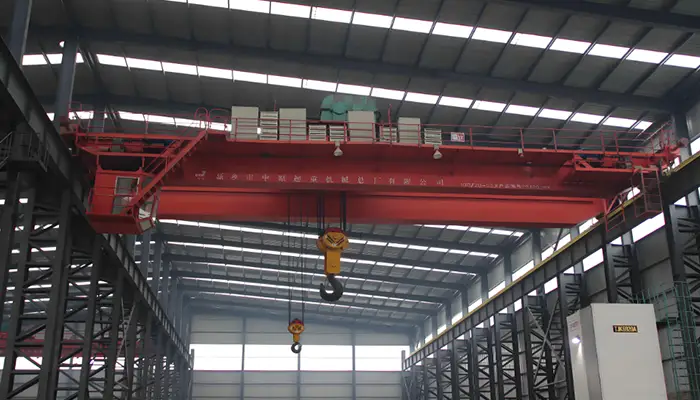
Open Winch Heavy Duty Overhead Crane
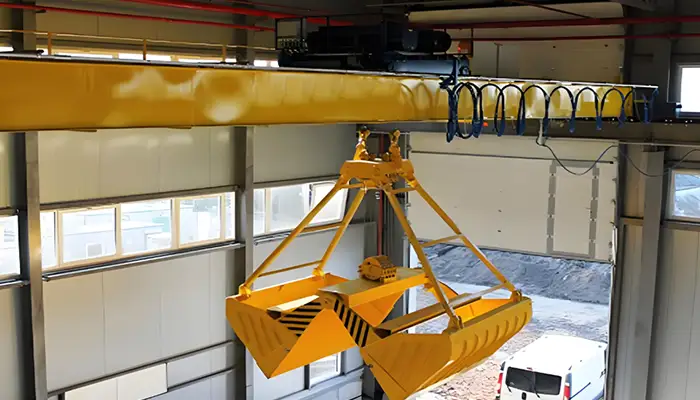
Grab Bucket Heavy Duty Overhead Crane
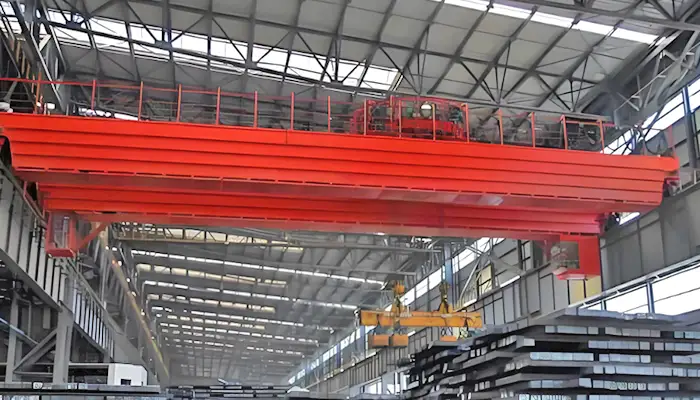
Magnetic Heavy Duty Overhead Crane
Heavy Duty Floor Cranes
Floor cranes are crucial for lifting and moving heavy loads within designated areas, often found in workshops, assembly lines, and outdoor settings. They are available in several configurations, including:
- Heavy Duty Floor Mounted Jib Cranes: These cranes feature a horizontal arm (jib) extending from a vertical post, allowing for flexible lifting and maneuvering. They are particularly effective in confined spaces and can be either floor-mounted or wall-mounted. Capacities for jib cranes can range from a few tons to over 10 tons.
- Heavy Duty Floor Traveling Gantry Cranes: Designed to straddle loads, gantry cranes are ideal for outdoor use or large warehouses. Their framework supports the lifting mechanism, and they can be equipped with wheels for easy mobility. Heavy-duty gantry cranes can handle substantial loads, often exceeding 20 tons, making them suitable for shipping yards, construction sites, and heavy manufacturing environments.
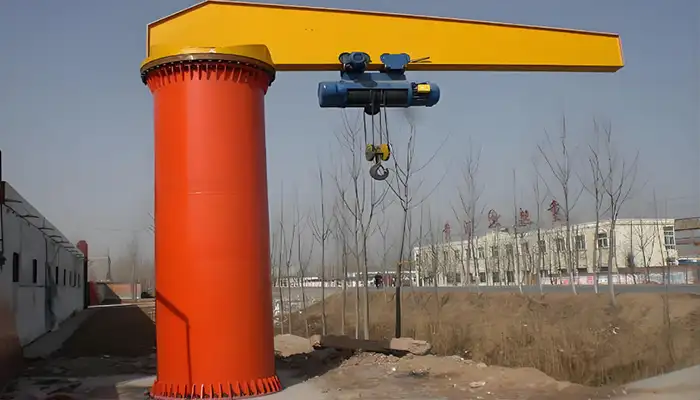
Heavy Duty Floor Mounted Jib Cranes
Heavy-duty floor cranes can be classified into several subtypes, each tailored for specific lifting tasks and operational environments. Theseclassifications enables businesses to choose the right floor crane for their needs. The main subtypes include:
Heavy Duty Jib Cranes: These cranes feature a horizontal arm (jib) that extends from a vertical post, allowing for flexible lifting within a defined area. They are ideal for tasks that require precise load handling in confined spaces.
- Floor Mounted Jib Cranes: Specifically designed for installation on the floor, these cranes offer stability and can be used in various industrial settings. Their capacities typically range from a few tons to over 10 tons, making them versatile for different applications.
- Anti-Corrosion Pillar Mounted Jib Cranes: Built to withstand harsh environments, these cranes feature anti-corrosion materials and coatings, making them suitable for industries such as marine and chemical processing where exposure to corrosive elements is a concern.
- High Working Frequency Jib Cranes: Designed for frequent operation, these cranes are optimized for rapid lifting and lowering cycles. They are often used in assembly lines or other high-demand environments where efficiency is crucial.
Heavy Duty Gantry Cranes: These cranes are designed to straddle loads and are particularly effective for outdoor use or in large indoor spaces. They offer high lifting capacities and flexibility in handling various loads.
- Double Girder Heavy Duty Gantry Cranes: Featuring a robust double girder design, these gantry cranes provide superior strength and stability. They can handle very heavy loads, making them suitable for heavy manufacturing and shipping applications.
- Rubber Tired Heavy Duty Gantry Cranes: Equipped with rubber tires, these gantry cranes offer mobility and flexibility, allowing for easy movement across different surfaces. They are commonly used in container handling at ports and shipping yards.
- Rail Mounted Heavy Duty Gantry Cranes: These cranes are mounted on rails, providing excellent stability and precise control for lifting heavy loads. Rail-mounted gantry cranes are often utilized in industrial settings, such as shipyards and large warehouses, where they can efficiently handle substantial materials.
By understanding these subtypes of heavy-duty floor cranes, businesses can make informed choices that align with their specific operational requirements, ensuring effective and safe material handling.
Application Environments
Heavy-duty cranes are engineered for specific environments, impacting their performance and selection. Understanding the two main categories—indoor heavy-duty shop cranes and outdoor cranes—can help businesses choose the right equipment for their needs.
Indoor Heavy-Duty Shop Cranes
Designed for enclosed spaces like factories, workshops, and warehouses, indoor heavy-duty cranes feature several key characteristics:
- Compact Design: These cranes often have a smaller footprint, optimizing space utilization in areas where maneuverability is limited. This design is crucial for operations in tight environments.
- Controlled Environment: Operating indoors means these cranes are less exposed to harsh weather, resulting in stable working conditions that enhance precision and safety during lifting tasks.
- Typical Uses: Common applications include assembly lines and material handling in manufacturing and warehousing. Indoor cranes may come equipped with specialized attachments, such as electric hoists, tailored to specific operational requirements.
Outdoor Cranes for Heavy Duty Material Handling
In contrast, outdoor cranes are built to endure a range of environmental challenges, making them suitable for construction sites, shipping yards, and other open-air applications. Key features include:
- Robust Construction: These cranes are constructed with durable materials designed to withstand elements like rain, wind, and extreme temperatures, ensuring reliable performance in tough conditions.
- Mobility: Many outdoor cranes, such as rubber-tired gantry cranes, are designed for mobility, enabling them to navigate various terrains and adapt to dynamic job sites.
- Typical Uses: Outdoor cranes are tasked with handling heavy loads, including steel beams, concrete blocks, and shipping containers. Their resilience and versatility make them essential for sectors like construction, logistics, and heavy manufacturing.
By recognizing the differences between indoor and outdoor heavy-duty cranes, businesses can make informed decisions that align with their operational environments and material handling needs. This understanding is crucial for optimizing efficiency and ensuring safety in various industrial applications.
Typical Crane Capacities
Overview of Capacity Ranges
Heavy-duty cranes come in various capacity ranges tailored for specific lifting tasks. Thesecommon capacities helps businesses select the right crane for their needs:
- 10 Tons: A 10-ton heavy-duty crane efficiently handles machinery components, such as electric motors or large castings. Its reliable performance is crucial in manufacturing environments, particularly in automotive assembly lines, where it positions engine parts for installation.
- 20 Tons: A 20-ton crane is ideal for managing heavier loads, such as large steel beams in construction projects. This crane ensures precise placement within structural frameworks, enhancing safety and integrity during the building process.
- 32 Tons: A 32-ton heavy-duty crane is employed in construction and heavy manufacturing, capable of lifting significant loads like precast concrete elements. Its strength makes it indispensable for operations requiring robust lifting solutions.
- 40 Tons: With a 40-ton capacity, this crane is utilized in heavy industries for lifting large components, including machinery and structural elements. Its substantial lifting power contributes to efficient and safe operations in various applications.
- 50 Tons: A 50-ton heavy-duty crane is essential in shipbuilding, capable of lifting large sections of hulls and major machinery components. This crane accelerates the construction process by positioning main engines into newly built vessels with ease.
- 75 Tons: A 75-ton crane is critical in sectors needing high lifting capabilities, such as heavy manufacturing and construction. It manages substantial loads, ensuring safe and efficient operations even in demanding environments.
- 80 Tons: An 80-ton heavy-duty crane offers enhanced lifting capabilities, suitable for handling significant structural elements. Its robust construction ensures reliable performance in challenging environments, such as construction sites and industrial facilities.
- 100 Tons and Above: High-capacity cranes exceeding 100 tons are vital for large-scale operations in industries like oil and gas exploration. These cranes can lift massive loads, including drilling rigs and large prefabricated structures. For instance, a 100-ton crane may be used in a petrochemical plant to install heavy reactors or tanks, showcasing its importance in complex industrial applications.
These capacity ranges allows businesses to select the right crane for their specific lifting tasks, optimizing efficiency and safety in their operations.
Relationship Between Capacity and Duty Rating
The capacity of a crane is closely related to its duty rating, which defines the intensity of work it is designed to handle.
Small Capacity Heavy Duty Cranes
Smaller capacity cranes, typically in the 10 to 20-ton range, can effectively meet heavy-duty specifications in various applications:
- Manufacturing Workshops: In a workshop setting, a 15-ton heavy-duty crane can lift and position large mechanical parts during assembly. For example, it can be used to move heavy conveyor belts or support structures, ensuring efficient workflow.
- Maintenance and Repair Operations: In facilities that maintain large equipment, such as power plants, a small capacity heavy-duty crane can lift and transport heavy pumps or motors, where precise handling is critical.
High Capacity Heavy Duty Cranes
High-capacity cranes, often exceeding 50 tons, are designed with specific features to handle demanding applications:
- Reinforced Structures: A 75-ton crane used in a construction site has a reinforced frame and upgraded components to support the heavy loads of steel girders or large concrete panels. This ensures stability and safety during lifting operations.
- Advanced Lifting Mechanisms: In a manufacturing facility, a high-capacity crane may utilize multiple winches to lift heavy machinery like lathes or milling machines, providing the strength and precision needed for safe placement.
- Safety Features: Cranes over 100 tons typically come equipped with advanced safety systems, such as overload sensors and automated control mechanisms. For instance, in a port, a 150-ton crane loading large shipping containers incorporates these features to prevent accidents during operations.
Light Duty vs. Heavy Duty Cranes
The difference between light duty and heavy duty cranes is essential for proper equipment selection:
- Light Duty Cranes: Generally rated for capacities under 10 tons, these cranes are suitable for lighter lifting tasks. For example, in a workshop, a light-duty crane might be used to move tools or small parts, such as automotive panels. They are typically used for less frequent tasks and may have a simpler design.
- Heavy Duty Cranes: Rated for higher capacities, these cranes are built for rigorous applications. For example, a heavy-duty crane rated at 20 tons can continuously operate in a manufacturing plant, moving heavy items like assembled machines or large components without compromising safety or efficiency.
By understanding the relationships between crane capacities and duty ratings, businesses can make informed decisions that ensure they select the right crane for their operational requirements, optimizing safety and efficiency in their material handling processes.
Heavy Duty Cranes in Key Industrial Sectors
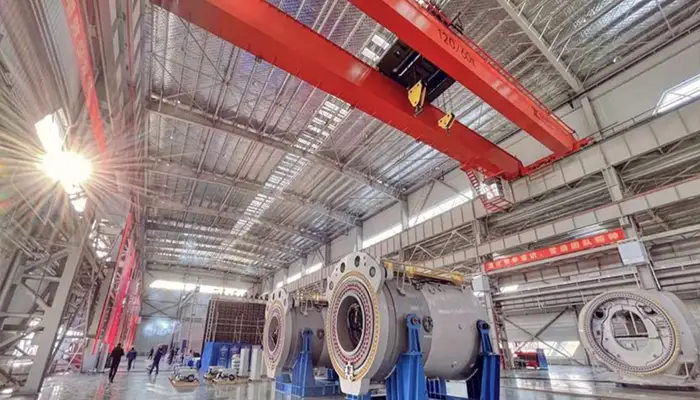
Metal Industry: Heavy Duty Cranes for Steel Mills
Heavy-duty overhead cranes are vital in the steel industry, where they facilitate the handling and transportation of raw materials, semi-finished products, and finished steel goods. These cranes are specially designed to operate in steel mills, where high temperatures, dust, and heavy loads present daily challenges.
Specialized Crane Types and Typical Loads:
- Charging Cranes: Used for loading scrap metal or raw materials into furnaces, these cranes are built to withstand extreme temperatures and harsh conditions.
- Ladle Cranes: Specifically designed for handling molten metal, ladle cranes ensure the safe transport of ladles filled with liquid steel, critical for efficient production.
- Billet Handling Cranes: Designed to manage billets and slabs, these cranes ensure smooth movement through various stages of steel production.
- Coil Handling Cranes: Used for transporting steel coils within the mill and to storage areas, these cranes are equipped with specialized lifting devices like C-hooks, coil tongs, or magnets.
Heavy-duty crane designs are adopted in this sector to ensure safety and reliability while managing the extreme conditions of steel production.
Construction Industry
In the construction sector, heavy-duty cranes are vital for lifting and transporting large materials critical to building projects. Their specialized designs and configurations ensure they can handle substantial loads while providing necessary stability and precision.
Specialized Crane Types and Typical Loads:
- Magnetic Beam Overhead Cranes: Often equipped with specialized lifting devices like spreader beams or hook attachments, these cranes are commonly used for lifting steel beams and precast concrete components. With capacities up to 50 tons, they facilitate efficient placement of structural supports in buildings and bridges.
- Heavy Duty Gantry Cranes: Designed for outdoor construction sites, these cranes feature robust frames capable of handling heavy loads such as concrete blocks and large equipment. Configured with lifting hooks or C-hooks, they enable quick and efficient assembly processes.
- Heavy Duty Jib Cranes: Ideal for tight spaces on construction sites, these cranes can pivot, allowing for versatile lifting angles. Often utilizing magnetic lifts for steel components, they are suitable for placing steel girders or handling tools and materials in confined areas.
The robust design and varied configurations of heavy-duty cranes in construction ensure they can withstand the rigors of lifting heavy loads while maintaining stability and precision.
Manufacturing and Assembly
In manufacturing and assembly operations, heavy-duty cranes are essential for moving large components and optimizing production lines, allowing for enhanced efficiency.
Specialized Crane Types and Typical Loads:
- Heavy Duty Indoor Cranes: Typically featuring electric hoists and adjustable lifting speeds, these cranes are used to lift and transport heavy machinery such as lathes and milling machines. A 30-ton indoor crane might be equipped with specialized attachments like hooks or tongs for precise placement during equipment installation.
- Heavy Duty Double Hoist Overhead Cranes: Often configured with dual hoists for lifting large assembly parts in automotive or aerospace industries, these cranes can handle significant components like engines or fuselage sections, streamlining assembly processes and minimizing downtime.
- Heavy Duty Jib Cranes: These cranes can be fitted with pneumatic or electric lifting devices, making them suitable for moving smaller, heavy parts or assembly tools directly to workstations, thereby improving efficiency on the production floor.
Heavy-duty cranes are engineered with specific configurations and lifting devices to provide the strength necessary for demanding tasks while ensuring operator safety and minimizing risk.
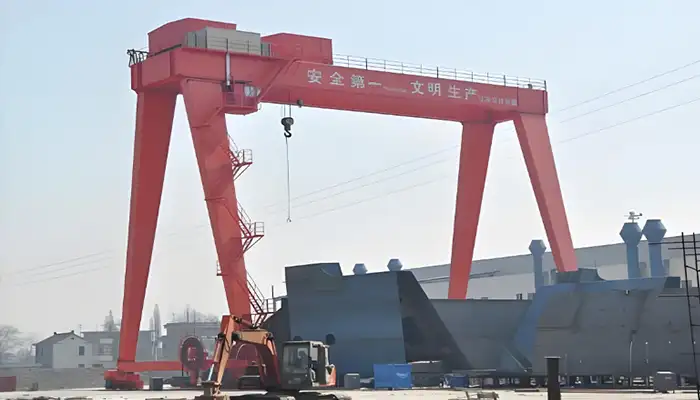
Shipbuilding and Marine Applications
The shipbuilding industry relies on specialized cranes to manage large and heavy loads, ensuring safety and efficiency in challenging environments.
Specialized Crane Types and Typical Loads:
- Heavy Duty Goliath Gantry Cranes: Often featuring modular designs with high lifting capacities, these cranes are used to lift and position hull sections during ship construction. They can be equipped with hooks and specialized clamps to securely handle massive steel components.
- Heavy Duty Overhead Cranes: Critical for installing large machinery like engines and turbines into vessels, these cranes often have high-precision lifting systems and below-hook devices such as lifting magnets or slings, ensuring safe handling and accuracy during assembly.
The heavy-duty design of cranes in shipbuilding allows for the safe handling of massive components, ensuring operational accuracy in demanding marine conditions.
Oil and Gas Industry
Heavy-duty cranes are indispensable in the oil and gas sector for various critical applications, supporting operational efficiency in challenging environments.
Specialized Crane Types and Typical Loads:
- Heavy Duty Outdoor Yard Cranes: These cranes are designed with enhanced weatherproofing and can be equipped with specialized lifting devices such as slings for securing drilling rigs and equipment. Their robust construction allows them to handle heavy offshore equipment safely.
- Explosion-Proof Gantry Cranes: In oil refineries, these cranes are vital for moving large components like reactors and separators. They are often configured with hydraulic lifting systems and custom below-hook devices to accommodate the specific shapes and weights of these industrial components.
The heavy-duty design of these cranes ensures they can endure the rigors of the oil and gas sector while maintaining operational safety and efficiency.
Mining and Heavy Machinery
In the mining industry, heavy-duty cranes are essential for managing large and heavy loads, ensuring continuous operational flow.
Specialized Crane Types and Typical Loads:
- Heavy Duty Grab Bucket Gantry Cranes: Used for handling mined materials like ore and rock, these cranes are equipped with below-hook devices such as bucket grabs or clamps, allowing for the efficient lifting of large containers for transport to processing facilities.
The robust design and specialized configurations of heavy-duty cranes in mining support the safe handling of heavy loads in demanding environments, enhancing productivity and safety.
Considerations for Buyers
Defining Crane Duty Rating
When purchasing a crane, it’s essential to classify it correctly as either light or heavy duty. This classification influences the crane’s design, materials, and overall performance. Here are some guidelines to help in this process:
- Understanding Duty Ratings: Light-duty cranes are typically rated for loads up to 10 tons and are suitable for infrequent or lighter tasks. In contrast, heavy-duty cranes are designed for continuous operation and can handle loads exceeding 10 tons. For instance, if your operations require lifting heavy machinery daily, a heavy-duty classification is necessary.
- Assessing Usage Frequency: Evaluate how often the crane will be used. If the crane is required for regular, high-volume lifting tasks, it should be classified as heavy duty. For example, a crane used in a manufacturing line that operates multiple shifts would qualify as heavy duty.
- Load Requirements: Determine the maximum load the crane will need to handle. If you anticipate lifting heavier components regularly, ensure that the crane is designed with appropriate duty ratings to support these demands.
Confirming Crane Capacity
Choosing the right crane capacity is crucial for safe and efficient operations. Here are steps to assess the appropriate capacity for specific applications:
- Analyze Load Requirements: Identify the heaviest loads the crane will handle. For instance, if you plan to lift large steel beams weighing up to 20 tons, select a crane that exceeds this weight to ensure a safety margin.
- Consider Load Types: Different loads may require different handling considerations. For example, handling bulky or awkwardly shaped items may necessitate a higher capacity crane due to the need for stability and control.
- Evaluate Environmental Factors: Consider the environment in which the crane will operate. Outdoor conditions, such as wind or uneven surfaces, can affect lifting capacity and stability. Adjust your capacity requirements accordingly to ensure safe operation.
Consulting with Manufacturers
Engaging with crane manufacturers or suppliers is critical for making informed purchasing decisions. Here’s why:
- Expert Advice: Manufacturers have in-depth knowledge of crane specifications and can provide valuable insights into selecting the right equipment based on your operational needs. They can help clarify the distinctions between various crane types and capacities.
- Customization Options: Many manufacturers offer customizable features to enhance crane functionality. Discussing your specific needs with them can lead to tailored solutions that improve efficiency and safety in your operations.
- After-Sales Support: Building a relationship with manufacturers can ensure you have ongoing support for maintenance, repairs, and potential upgrades, helping to prolong the lifespan of your crane and enhance its performance.
By carefully considering duty ratings, confirming capacity requirements, and consulting with manufacturers, buyers can make informed decisions that ensure the right heavy-duty crane is selected for their specific industrial applications, enhancing both safety and operational efficiency.
Conclusion
In summary, understanding the relationship between crane designs, capacities, and industrial applications is essential for businesses that rely on heavy-duty cranes. Each crane type, whether it be an overhead or floor crane, is engineered to meet specific lifting tasks and environmental conditions. The capacity of a crane is crucial, as it directly impacts its suitability for various applications, from construction and manufacturing to shipbuilding and mining.
Careful selection of the right crane is vital to ensure operational efficiency, safety, and reliability. Misjudging the required capacity or duty rating can lead to costly downtimes or safety hazards. By taking the time to analyze operational needs and engage with experts, buyers can make informed decisions that align with their long-term goals.
We encourage all potential buyers to seek expert consultations or product demonstrations to better understand their crane requirements. Engaging with knowledgeable manufacturers can provide insights that ensure the right crane is chosen for your specific applications. Don’t hesitate to explore your options thoroughly—investing in the right equipment is crucial for the success of your operations.
Main Projects
Related Products

Supplied three grab bucket crane kits to Indonesia, enhancing garbage handling efficiency with high load capacity and reliable performance.
Free consultation to Confirm Parameters & Specifications and Get
Latest Crane Price & Crane Rate.
- Types of overhead cranes : _______?
- Optional: Overhead travelling crane, goliath gantry crane,Slewing jib crane, Single girder or double girder crane,small portable crane or kbk crane, etc.
- Capacity of overhead crane: _______?
- Optional: 0.25ton, 0.5 ton, 1 ton, 2 ton, 3ton, 5 ton, 10 ton,15ton, 20ton, 25 ton, 30ton,35ton, up to 550ton, etc.
- Crane span & lifting height : _______?
- Crane travelling length : _____?
- Control of overhead crane:_______?
- Optional: pendant/ remote/cabin control
- Voltage supply of overhead crane:_____?
- Eg,: 380V50/60HZ,3Phase or others,etc.
- Application/usage of crane:_______?
- Eg,: Steel mill, ,injection mold, cement,stone, concrete,granite, general manufacturing, etc.
Just leave a message via the contact form and our hoist and crane engineer will contact you with in 24working hours.
Get In Touch
